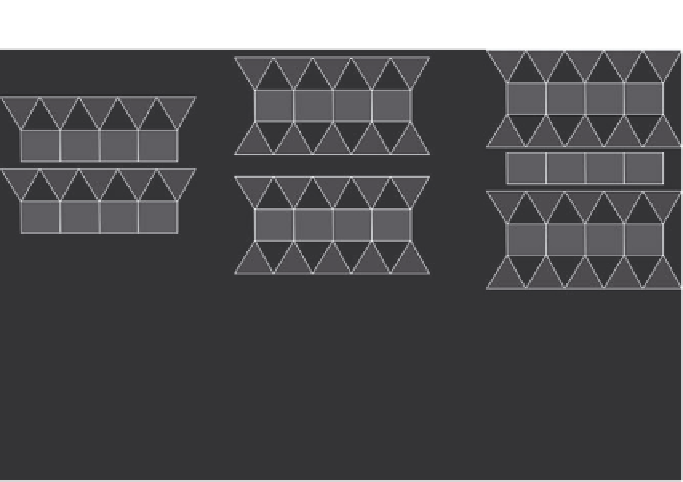Chemistry Reference
In-Depth Information
type TO
groupe de la kaolinite
type TOT
micas - illites
smectites
sheet:
octaedral layer
between two tetraedral layers
di-ou tri-octaedral
interlayer:
K: micas, illites
Ca, Na, (Mg, K.): smectites
chlorites
sheet:
on tétraedral layer
one octaedral layer
di-octaedral
bonded by weak
hydrogen-bonds
alternating sheet of TOT talc type
(octaedral layer
between two tetraedral layer)
and sheets of brucite type, octaedral
Figure 3.40
Structure clay minerals and chlorites.
Two types of sheets occur:
1
TO type structures (also said 1/1), consisting of a tetrahedral layer and
an octahedral layer; TO structure is characteristic of minerals of the
kaolinite group.
2
TOT type structures (also said 2/1): two tetrahedral layers with inverted
apexes, sandwiching an octahedral layer. The filling of the octahedral
layer can be of 2 (dioctahedral sheets) or 3 (trioctahedral sheets) cations
per unit cell. This type of structure occurs in micas, illites, smectites,
vermiculites and chlorites.
The interlayer that connects the sheets is also of several types:
1
There is no interlayer; bonding between the sheets are hydrogen bond-
ing; this occurs in kaolinite/dickite/nacrite, and, outside of the clay min-
erals, in talc and pyrophyllite.
2
Interlayer consists of potassium ions in micas and clays of the illite
group; in the latter the interlayer is not complete.
3
In the group of smectites, interlayer has a very incomplete filling of
Ca
++
and/or Na
+
(and minor quantities of K, Cs, Sr, Mg, H), these ions
are easily exchanged. These absorbing properties are used in indus-
trial use of these minerals, such as in fuller's earth formed mostly of
montmorillonites.





























